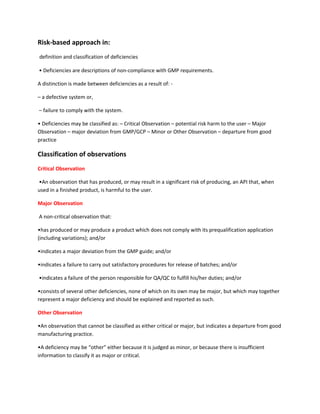
Risk minor major critical
- 1. Risk-based approach in: definition and classification of deficiencies • Deficiencies are descriptions of non-compliance with GMP requirements. A distinction is made between deficiencies as a result of: - – a defective system or, – failure to comply with the system. • Deficiencies may be classified as: – Critical Observation – potential risk harm to the user – Major Observation – major deviation from GMP/GCP – Minor or Other Observation – departure from good practice Classification of observations Critical Observation •An observation that has produced, or may result in a significant risk of producing, an API that, when used in a finished product, is harmful to the user. Major Observation A non-critical observation that: •has produced or may produce a product which does not comply with its prequalification application (including variations); and/or •indicates a major deviation from the GMP guide; and/or •indicates a failure to carry out satisfactory procedures for release of batches; and/or •indicates a failure of the person responsible for QA/QC to fulfill his/her duties; and/or •consists of several other deficiencies, none of which on its own may be major, but which may together represent a major deficiency and should be explained and reported as such. Other Observation •An observation that cannot be classified as either critical or major, but indicates a departure from good manufacturing practice. •A deficiency may be “other” either because it is judged as minor, or because there is insufficient information to classify it as major or critical.
- 5. Pfizer 10 Step Process Pfizer 10 step process13p 1. Collect & Organize the information Gathering relevant information, reviewing appropriate references & identifying assumptions Tools can be used to organize the information Define the boundaries of the QRM exercise 2. Formulate the Risk Question: Starting point of the QRM exercise, high level statement outlining the issue & purpose for conducting the QRM exercise including risk factors, the scope of the issue and any related limits or constraints Example: What is the supplier audit schedule that will ensure that suppliers presenting a high risk to the patient are audited in a more frequent manner? 3. Choose Tool Basic risk management facilitation methods (flowcharts, check sheets etc) Failure Mode Effects Analysis & Failure Mode Effects & Criticality Analysis Fault Tree Analysis Hazard Analysis & Critical Control Points Hazard & Operability Analysis Preliminary Hazard Analysis Risk Ranking & Filtering Supporting statistical tools Risk Management Tool adapted from The development of a Quality Risk Management solution designed to facilitate compliance with the risk‐based
- 6. qualification, validation and change control GMP requirement of the EU. Dublin : Dublin Institute of Technology, 2007 . Kevin O'Donnell PhD 4. Identify Risks Factors and Related Hazards: What are the Risk Factors (patient safety, compliance and business) arising from all potential hazards identified? 5. Define the Risk Components & Scales What does Severity, Probability & Detection mean in terms of this Risk Question? In terms of a QRM exercise to create a supplier audit schedule Severity ‐ Criticality of the product Probability ‐ Complexity of the site (multi‐product) Detection ‐ Audit history Severity Scale Factor Definition 10 Sterile products 6 Product orally administered 3 Topical products and compounds not directly used by patient 1 Compounds used during manufacturing process
- 7. 6. Create matrix 7. Determine Action Threshold •A level or value above which an action will take place and below which it will not 8. Apply the tool • Analyze the detailed risks and quantify those risks using the scales for severity, probability and detection to provide a risk score •Determine what actions are required based on the threshold for action
- 8. 9. Define Risk Mitigation Consider measures/actions that could: Decrease the severity stop failure before significant consequences, reject, recall Decrease the probability Inspect defect out of batch Increase the detection Move from manual to machine inspection Reapply the tool taking the mitigating measures into consideration Determine if the mitigations/actions have introduced new risks 10. Document and Approve •Document and approve in a Quality Risk Assessment Report
